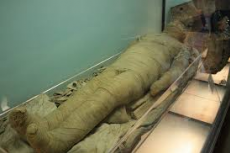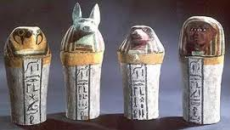
Let's travel four thousand years in the past and talk about mummies, and no I don't mean that lovely lady who brought you into this world, I mean the Egyptian mummies wrapped in bandages and laid to rest in a great sarcophagus (fancy coffin). A mummy is a deceased (dead) person or animal (yes cats were mummified) whose skin and organs are preserved by their conditions, for example extreme cold, a lack of air or low humidity could cause the body to be almost perfectly preserved. As a result the Ancient Egyptian Pharoahs and anyone who was mummified is still preserved somewhat 4000 years later whereas usually a body would be no more than a skeleton long before that time. Interestingly, mummification is not only unique to Egypt and several mummies both human and animal have been found across South America and Asia and the oldest dated mummified item is a 6000 year old head found in a tomb in South America. The almost perfect preservation of some bodies allows scientists to more easily virtually construct features for these people and work out how they would have looked without the assistance of paintings or drawings; amazing!
The idea of a perfectly preserved human being post mortem (after death) has led to several horror stories and films about mummies coming back to life and being cursed as their spirit never escaped their body and is tormented, luckily for us all in reality mummies are long dead. This ascension of the spirit was the main purpose of mummification at least in Ancient Egypt and ties in with the pyramids as I mentioned in a previous article. The bodies were 'cleansed' and preserved by chemicals aswell as being placed in a sealed tight container (the sarcophagus) within a pyramid where the theory was that their spirit would ascend; the reason for preserving the body after death was because Ancient Egyptians believed that the deceased would carry their body with them (spiritually) into the afterlife and so needed it intact and not decaying.

So now we know why people and animals were mummified, let's talk a little about the mummification process. In order to preserve the mummies within the great heat they embalmed the bodies and wrapped them in linen (the bandages);the embalming process is a bit of a gruesome one, here's where history becomes horrible. First of all the dead body is taken to a tent called the 'ibu' which means place of purification and here they are washed in wine and water from the nile to create a pleasant smell. A cut is then made in the side of the body and the liver,lungs, stomach and intestines are removed and washed as they would decompose quickest after death. They are then wrapped in natron (a type of salt) in order to help preserve and cleanse them. The heart is not removed because it was seen as the centre of a person's emotions and being and so they would need it in the afterlife (remember that this whole process was about preparing the body for ascension to the afterlife). Perhaps the worst part comes next, a long hook was inserted through the nose and up into the brain with which the embalmers would smash the brain into smaller pieces and pull it out through the nose, eurgh yuck! Today we know that the brain is the centre of communications in our body and that, as important as the heart is for pumping blood around the body and keeping our muscles moving, the brain controls the entire body. However in Ancient Egypt they considered the heart the most important organ.
The body is now covered and filled with the natron salt in order to help preserve it and all the removed fluids and organs are kept in bags and will be buried with the person or animal. Forty days later the body is washed again with water from the nile and rubbed with oils to further help preservation. The organs are now deflated and dehydrated without liquids and are wrapped in linen and placed back inside the body. Dry materials such as sawdust and leaves are used also to stuff the body and make it appear more lifelike before it is finally wrapped in linen to help preserve it further. In the earliest mummification rituals the organs were not returned to the body but instead placed in small canopic jars that were buried with the body. These jars each represented an Egpytian God which would care for the different organs, these four gods were the four sons of Horus (the patron god of Ancient Egypt). Imsety, the human faced God would look after the liver, Hapy the baboon faced God would look after the lungs, Duamutef the Jackal faced God would look after the stomach and Qebehsenuef the falcon faced God would look after the intestines. In the later years of Ancient Egpyt they began instead to place the organs back inside the body as i previously explained but they still buried these four jars with them also to supposedly help spiritually preserve them. The picture on the right shows these four canopic jars; note that the pottery has also been preserved well by the sealed conditions within the sarcophagus.
So there you have it, pyramids and mummies were both all about preparing the dead to reach the afterlife, but some people suggest otherwise and have their own theories on the purpose of mummies, some interesting, some sinister. Decide for yourself and comment any interesting responses or knowledge you have about Ancient Egypt in the comments section below this article, hope to hear from you!

0 Comment:
Be the first one to comment on this article.